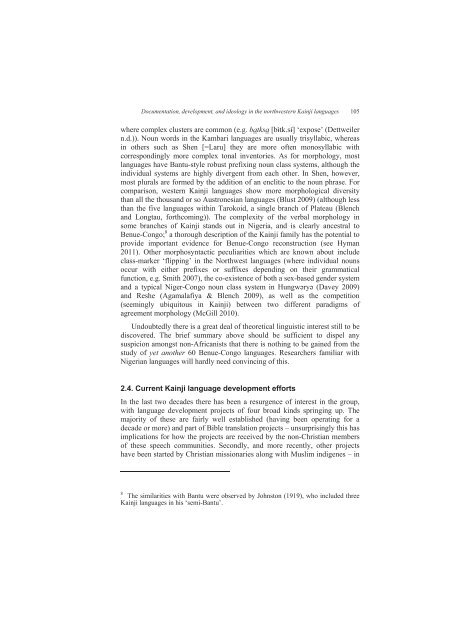Documentation, development, and ideology in the ... - Roger Blench
Documentation, development, and ideology in the ... - Roger Blench
Documentation, development, and ideology in the ... - Roger Blench
You also want an ePaper? Increase the reach of your titles
YUMPU automatically turns print PDFs into web optimized ePapers that Google loves.
<strong>Documentation</strong>, <strong>development</strong>, <strong>and</strong> <strong>ideology</strong> <strong>in</strong> <strong>the</strong> northwestern Ka<strong>in</strong>ji languages 105<br />
where complex clusters are common (e.g. batksa [] ‘expose’ (Dettweiler<br />
n.d.)). Noun words <strong>in</strong> <strong>the</strong> Kambari languages are usually trisyllabic, whereas<br />
<strong>in</strong> o<strong>the</strong>rs such as Shen [=Laru] <strong>the</strong>y are more often monosyllabic with<br />
correspond<strong>in</strong>gly more complex tonal <strong>in</strong>ventories. As for morphology, most<br />
languages have Bantu-style robust prefix<strong>in</strong>g noun class systems, although <strong>the</strong><br />
<strong>in</strong>dividual systems are highly divergent from each o<strong>the</strong>r. In Shen, however,<br />
most plurals are formed by <strong>the</strong> addition of an enclitic to <strong>the</strong> noun phrase. For<br />
comparison, western Ka<strong>in</strong>ji languages show more morphological diversity<br />
than all <strong>the</strong> thous<strong>and</strong> or so Austronesian languages (Blust 2009) (although less<br />
than <strong>the</strong> five languages with<strong>in</strong> Tarokoid, a s<strong>in</strong>gle branch of Plateau (<strong>Blench</strong><br />
<strong>and</strong> Longtau, forthcom<strong>in</strong>g)). The complexity of <strong>the</strong> verbal morphology <strong>in</strong><br />
some branches of Ka<strong>in</strong>ji st<strong>and</strong>s out <strong>in</strong> Nigeria, <strong>and</strong> is clearly ancestral to<br />
Benue-Congo; 8 a thorough description of <strong>the</strong> Ka<strong>in</strong>ji family has <strong>the</strong> potential to<br />
provide important evidence for Benue-Congo reconstruction (see Hyman<br />
2011). O<strong>the</strong>r morphosyntactic peculiarities which are known about <strong>in</strong>clude<br />
class-marker ‘flipp<strong>in</strong>g’ <strong>in</strong> <strong>the</strong> Northwest languages (where <strong>in</strong>dividual nouns<br />
occur with ei<strong>the</strong>r prefixes or suffixes depend<strong>in</strong>g on <strong>the</strong>ir grammatical<br />
function, e.g. Smith 2007), <strong>the</strong> co-existence of both a sex-based gender system<br />
<strong>and</strong> a typical Niger-Congo noun class system <strong>in</strong> Hungwry (Davey 2009)<br />
<strong>and</strong> Reshe (Agamalafiya & <strong>Blench</strong> 2009), as well as <strong>the</strong> competition<br />
(seem<strong>in</strong>gly ubiquitous <strong>in</strong> Ka<strong>in</strong>ji) between two different paradigms of<br />
agreement morphology (McGill 2010).<br />
Undoubtedly <strong>the</strong>re is a great deal of <strong>the</strong>oretical l<strong>in</strong>guistic <strong>in</strong>terest still to be<br />
discovered. The brief summary above should be sufficient to dispel any<br />
suspicion amongst non-Africanists that <strong>the</strong>re is noth<strong>in</strong>g to be ga<strong>in</strong>ed from <strong>the</strong><br />
study of yet ano<strong>the</strong>r 60 Benue-Congo languages. Researchers familiar with<br />
Nigerian languages will hardly need conv<strong>in</strong>c<strong>in</strong>g of this.<br />
2.4. Current Ka<strong>in</strong>ji language <strong>development</strong> efforts<br />
In <strong>the</strong> last two decades <strong>the</strong>re has been a resurgence of <strong>in</strong>terest <strong>in</strong> <strong>the</strong> group,<br />
with language <strong>development</strong> projects of four broad k<strong>in</strong>ds spr<strong>in</strong>g<strong>in</strong>g up. The<br />
majority of <strong>the</strong>se are fairly well established (hav<strong>in</strong>g been operat<strong>in</strong>g for a<br />
decade or more) <strong>and</strong> part of Bible translation projects – unsurpris<strong>in</strong>gly this has<br />
implications for how <strong>the</strong> projects are received by <strong>the</strong> non-Christian members<br />
of <strong>the</strong>se speech communities. Secondly, <strong>and</strong> more recently, o<strong>the</strong>r projects<br />
have been started by Christian missionaries along with Muslim <strong>in</strong>digenes – <strong>in</strong><br />
8 The similarities with Bantu were observed by Johnston (1919), who <strong>in</strong>cluded three<br />
Ka<strong>in</strong>ji languages <strong>in</strong> his ‘semi-Bantu’.
















